HLTEN508B: Analysis of Nursing Ethics and Professional Standards
VerifiedAdded on 2020/04/01
|13
|3038
|243
Homework Assignment
AI Summary
This assignment analyzes a nursing ethics case study involving an Enrolled Nurse's breach of professional conduct. The analysis covers violations of the scope of practice, failure to use critical thinking, and ethical breaches related to medication administration and record falsification. The assignment addresses specific questions regarding the nurse's actions, referencing the Nursing and Midwifery Board of Australia's professional standards, Code of Ethics, and Code of Professional Conduct. It examines the nurse's failure to adhere to contemporary nursing practices, relevant legislation (Health Practitioner Regulation National Law Act 2009), and the importance of continuous professional development. The assignment also highlights the significance of reflective practice in nursing and the potential benefits of this case study for the student's professional development. The document includes an analysis of a journal article regarding the scope of practice for Australian enrolled nurses.
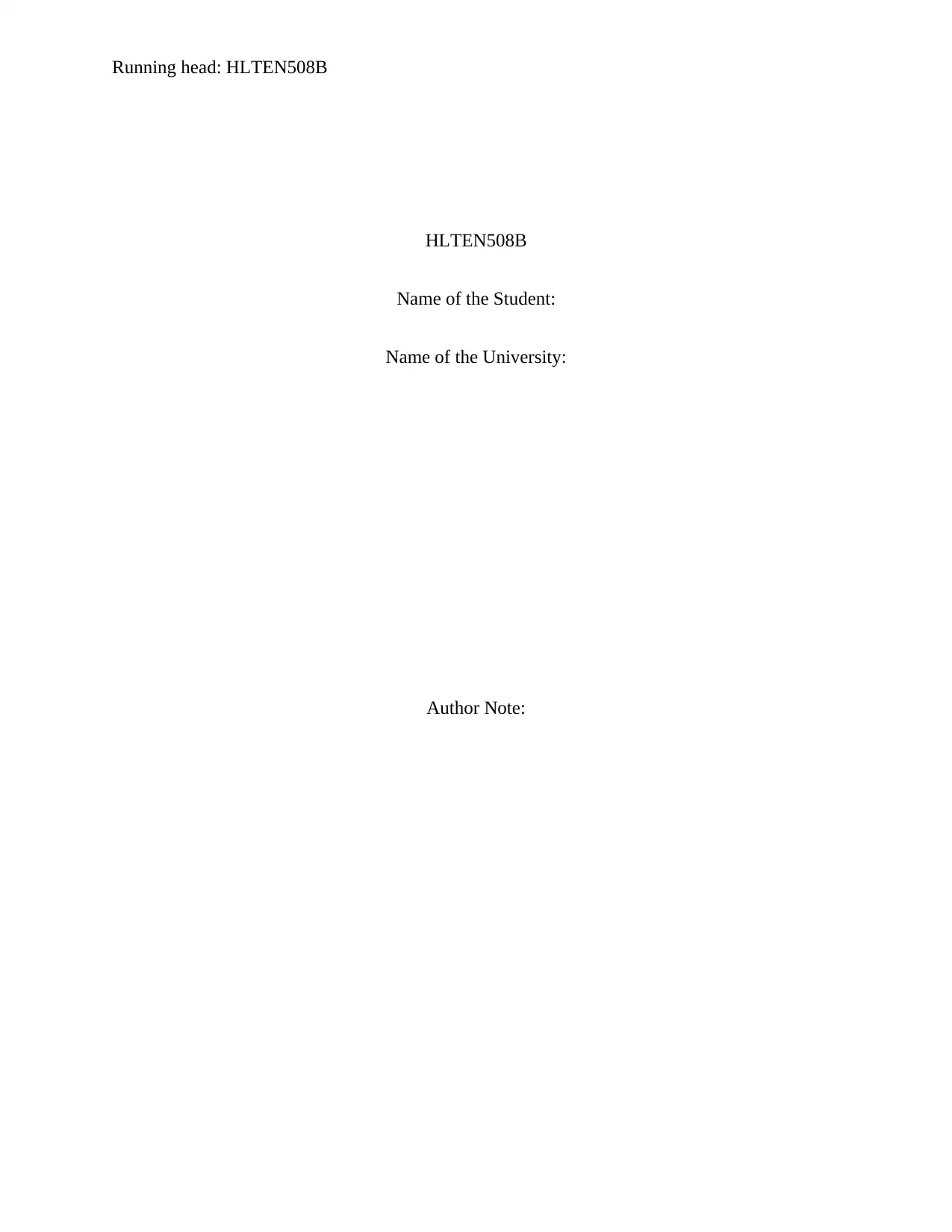
Running head: HLTEN508B
HLTEN508B
Name of the Student:
Name of the University:
Author Note:
HLTEN508B
Name of the Student:
Name of the University:
Author Note:
Paraphrase This Document
Need a fresh take? Get an instant paraphrase of this document with our AI Paraphraser
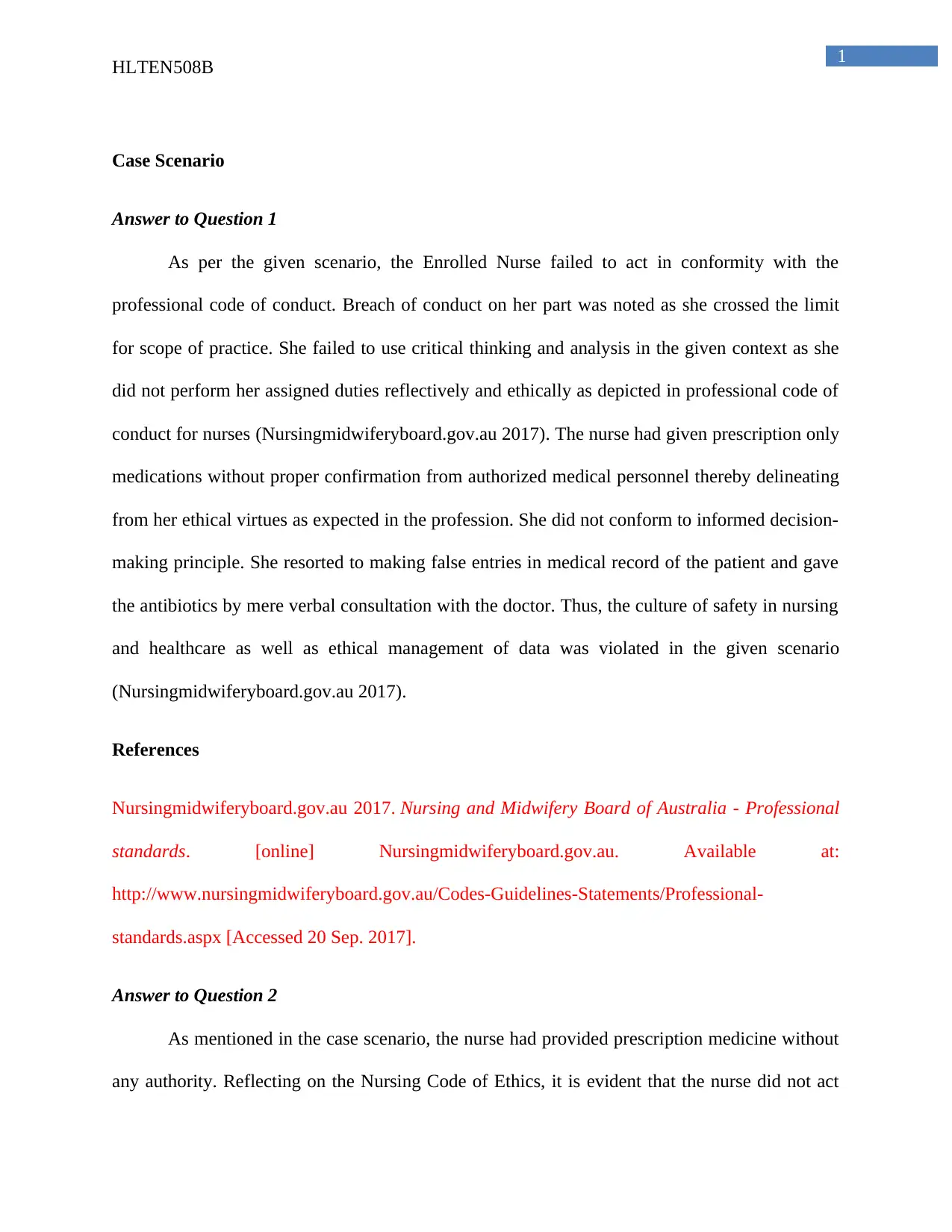
1
HLTEN508B
Case Scenario
Answer to Question 1
As per the given scenario, the Enrolled Nurse failed to act in conformity with the
professional code of conduct. Breach of conduct on her part was noted as she crossed the limit
for scope of practice. She failed to use critical thinking and analysis in the given context as she
did not perform her assigned duties reflectively and ethically as depicted in professional code of
conduct for nurses (Nursingmidwiferyboard.gov.au 2017). The nurse had given prescription only
medications without proper confirmation from authorized medical personnel thereby delineating
from her ethical virtues as expected in the profession. She did not conform to informed decision-
making principle. She resorted to making false entries in medical record of the patient and gave
the antibiotics by mere verbal consultation with the doctor. Thus, the culture of safety in nursing
and healthcare as well as ethical management of data was violated in the given scenario
(Nursingmidwiferyboard.gov.au 2017).
References
Nursingmidwiferyboard.gov.au 2017. Nursing and Midwifery Board of Australia - Professional
standards. [online] Nursingmidwiferyboard.gov.au. Available at:
http://www.nursingmidwiferyboard.gov.au/Codes-Guidelines-Statements/Professional-
standards.aspx [Accessed 20 Sep. 2017].
Answer to Question 2
As mentioned in the case scenario, the nurse had provided prescription medicine without
any authority. Reflecting on the Nursing Code of Ethics, it is evident that the nurse did not act
HLTEN508B
Case Scenario
Answer to Question 1
As per the given scenario, the Enrolled Nurse failed to act in conformity with the
professional code of conduct. Breach of conduct on her part was noted as she crossed the limit
for scope of practice. She failed to use critical thinking and analysis in the given context as she
did not perform her assigned duties reflectively and ethically as depicted in professional code of
conduct for nurses (Nursingmidwiferyboard.gov.au 2017). The nurse had given prescription only
medications without proper confirmation from authorized medical personnel thereby delineating
from her ethical virtues as expected in the profession. She did not conform to informed decision-
making principle. She resorted to making false entries in medical record of the patient and gave
the antibiotics by mere verbal consultation with the doctor. Thus, the culture of safety in nursing
and healthcare as well as ethical management of data was violated in the given scenario
(Nursingmidwiferyboard.gov.au 2017).
References
Nursingmidwiferyboard.gov.au 2017. Nursing and Midwifery Board of Australia - Professional
standards. [online] Nursingmidwiferyboard.gov.au. Available at:
http://www.nursingmidwiferyboard.gov.au/Codes-Guidelines-Statements/Professional-
standards.aspx [Accessed 20 Sep. 2017].
Answer to Question 2
As mentioned in the case scenario, the nurse had provided prescription medicine without
any authority. Reflecting on the Nursing Code of Ethics, it is evident that the nurse did not act
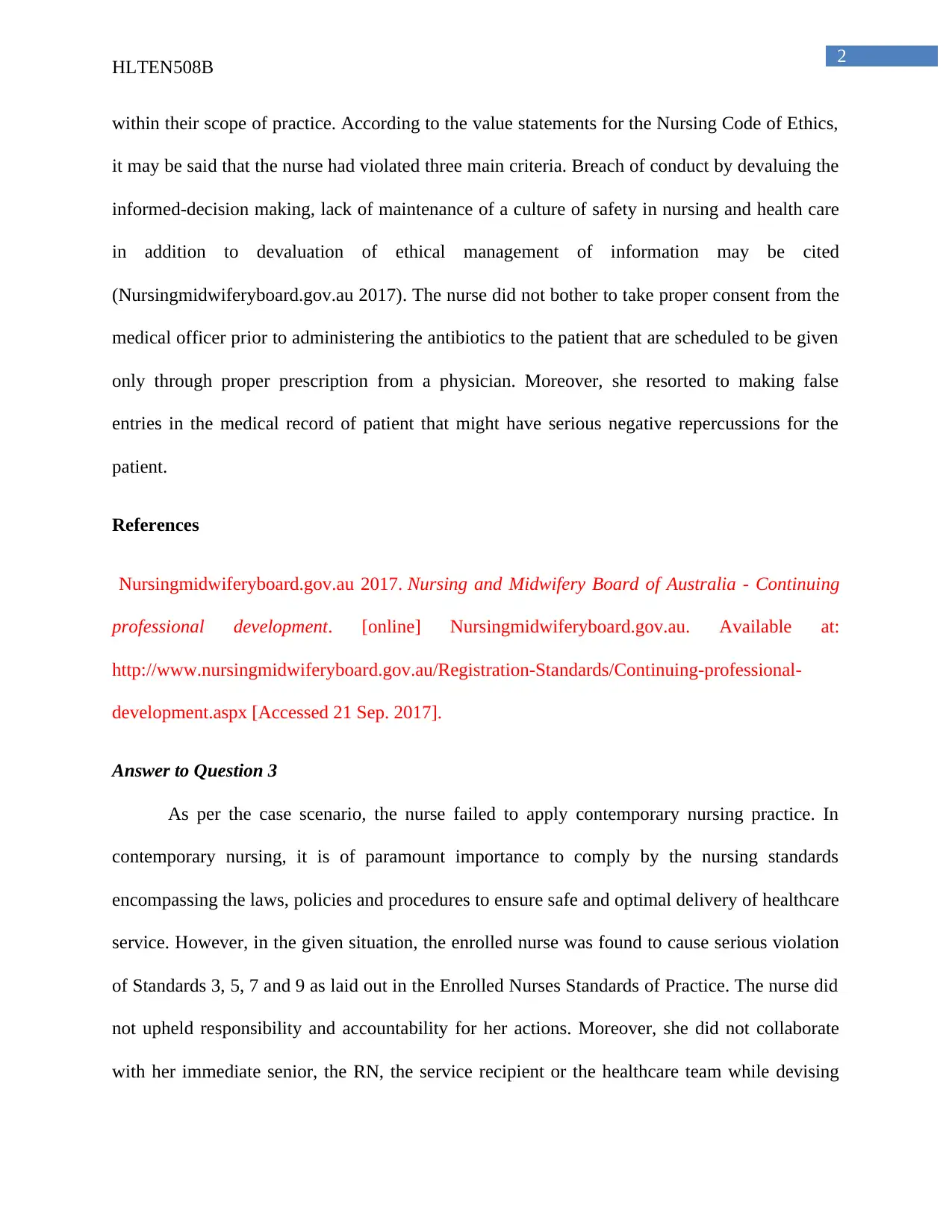
2
HLTEN508B
within their scope of practice. According to the value statements for the Nursing Code of Ethics,
it may be said that the nurse had violated three main criteria. Breach of conduct by devaluing the
informed-decision making, lack of maintenance of a culture of safety in nursing and health care
in addition to devaluation of ethical management of information may be cited
(Nursingmidwiferyboard.gov.au 2017). The nurse did not bother to take proper consent from the
medical officer prior to administering the antibiotics to the patient that are scheduled to be given
only through proper prescription from a physician. Moreover, she resorted to making false
entries in the medical record of patient that might have serious negative repercussions for the
patient.
References
Nursingmidwiferyboard.gov.au 2017. Nursing and Midwifery Board of Australia - Continuing
professional development. [online] Nursingmidwiferyboard.gov.au. Available at:
http://www.nursingmidwiferyboard.gov.au/Registration-Standards/Continuing-professional-
development.aspx [Accessed 21 Sep. 2017].
Answer to Question 3
As per the case scenario, the nurse failed to apply contemporary nursing practice. In
contemporary nursing, it is of paramount importance to comply by the nursing standards
encompassing the laws, policies and procedures to ensure safe and optimal delivery of healthcare
service. However, in the given situation, the enrolled nurse was found to cause serious violation
of Standards 3, 5, 7 and 9 as laid out in the Enrolled Nurses Standards of Practice. The nurse did
not upheld responsibility and accountability for her actions. Moreover, she did not collaborate
with her immediate senior, the RN, the service recipient or the healthcare team while devising
HLTEN508B
within their scope of practice. According to the value statements for the Nursing Code of Ethics,
it may be said that the nurse had violated three main criteria. Breach of conduct by devaluing the
informed-decision making, lack of maintenance of a culture of safety in nursing and health care
in addition to devaluation of ethical management of information may be cited
(Nursingmidwiferyboard.gov.au 2017). The nurse did not bother to take proper consent from the
medical officer prior to administering the antibiotics to the patient that are scheduled to be given
only through proper prescription from a physician. Moreover, she resorted to making false
entries in the medical record of patient that might have serious negative repercussions for the
patient.
References
Nursingmidwiferyboard.gov.au 2017. Nursing and Midwifery Board of Australia - Continuing
professional development. [online] Nursingmidwiferyboard.gov.au. Available at:
http://www.nursingmidwiferyboard.gov.au/Registration-Standards/Continuing-professional-
development.aspx [Accessed 21 Sep. 2017].
Answer to Question 3
As per the case scenario, the nurse failed to apply contemporary nursing practice. In
contemporary nursing, it is of paramount importance to comply by the nursing standards
encompassing the laws, policies and procedures to ensure safe and optimal delivery of healthcare
service. However, in the given situation, the enrolled nurse was found to cause serious violation
of Standards 3, 5, 7 and 9 as laid out in the Enrolled Nurses Standards of Practice. The nurse did
not upheld responsibility and accountability for her actions. Moreover, she did not collaborate
with her immediate senior, the RN, the service recipient or the healthcare team while devising
⊘ This is a preview!⊘
Do you want full access?
Subscribe today to unlock all pages.

Trusted by 1+ million students worldwide
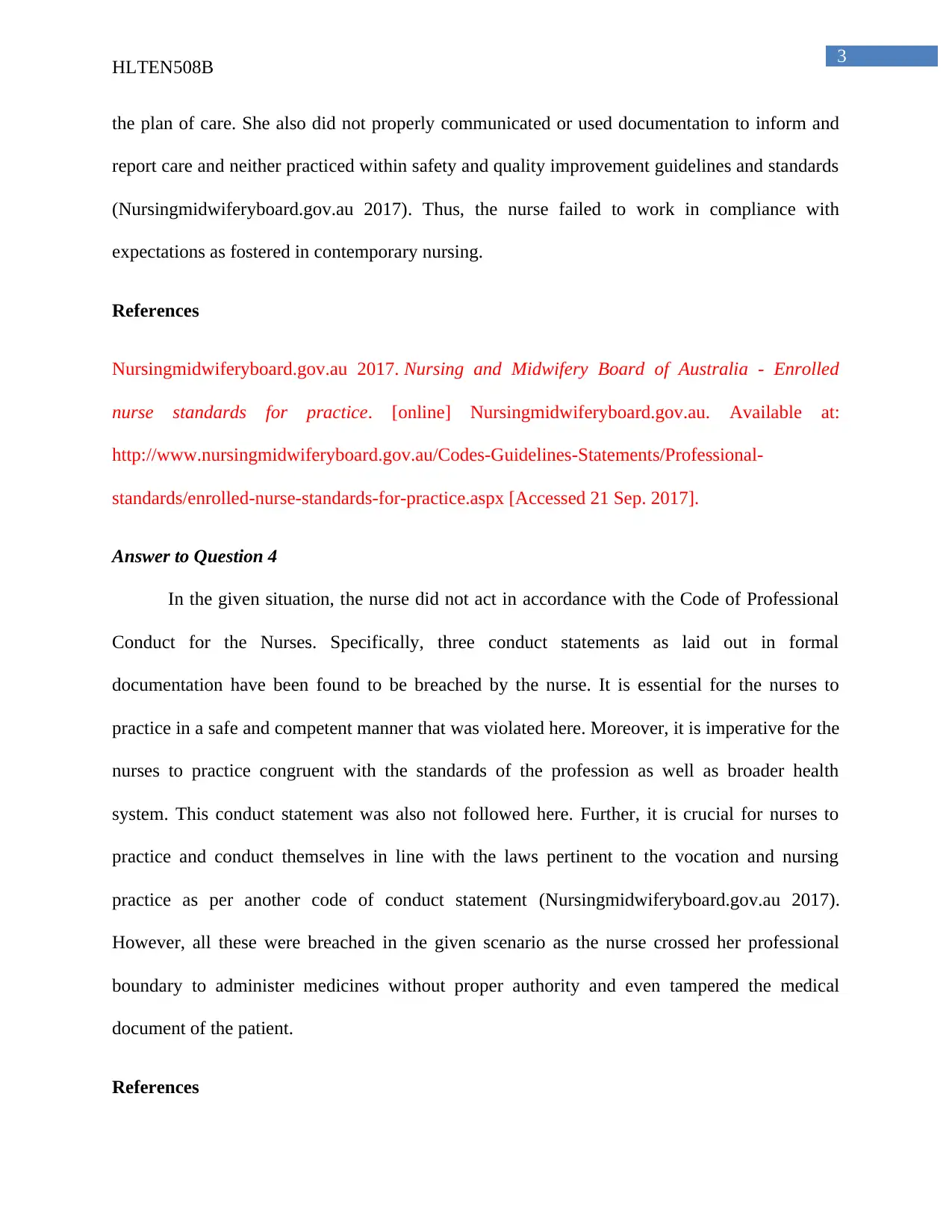
3
HLTEN508B
the plan of care. She also did not properly communicated or used documentation to inform and
report care and neither practiced within safety and quality improvement guidelines and standards
(Nursingmidwiferyboard.gov.au 2017). Thus, the nurse failed to work in compliance with
expectations as fostered in contemporary nursing.
References
Nursingmidwiferyboard.gov.au 2017. Nursing and Midwifery Board of Australia - Enrolled
nurse standards for practice. [online] Nursingmidwiferyboard.gov.au. Available at:
http://www.nursingmidwiferyboard.gov.au/Codes-Guidelines-Statements/Professional-
standards/enrolled-nurse-standards-for-practice.aspx [Accessed 21 Sep. 2017].
Answer to Question 4
In the given situation, the nurse did not act in accordance with the Code of Professional
Conduct for the Nurses. Specifically, three conduct statements as laid out in formal
documentation have been found to be breached by the nurse. It is essential for the nurses to
practice in a safe and competent manner that was violated here. Moreover, it is imperative for the
nurses to practice congruent with the standards of the profession as well as broader health
system. This conduct statement was also not followed here. Further, it is crucial for nurses to
practice and conduct themselves in line with the laws pertinent to the vocation and nursing
practice as per another code of conduct statement (Nursingmidwiferyboard.gov.au 2017).
However, all these were breached in the given scenario as the nurse crossed her professional
boundary to administer medicines without proper authority and even tampered the medical
document of the patient.
References
HLTEN508B
the plan of care. She also did not properly communicated or used documentation to inform and
report care and neither practiced within safety and quality improvement guidelines and standards
(Nursingmidwiferyboard.gov.au 2017). Thus, the nurse failed to work in compliance with
expectations as fostered in contemporary nursing.
References
Nursingmidwiferyboard.gov.au 2017. Nursing and Midwifery Board of Australia - Enrolled
nurse standards for practice. [online] Nursingmidwiferyboard.gov.au. Available at:
http://www.nursingmidwiferyboard.gov.au/Codes-Guidelines-Statements/Professional-
standards/enrolled-nurse-standards-for-practice.aspx [Accessed 21 Sep. 2017].
Answer to Question 4
In the given situation, the nurse did not act in accordance with the Code of Professional
Conduct for the Nurses. Specifically, three conduct statements as laid out in formal
documentation have been found to be breached by the nurse. It is essential for the nurses to
practice in a safe and competent manner that was violated here. Moreover, it is imperative for the
nurses to practice congruent with the standards of the profession as well as broader health
system. This conduct statement was also not followed here. Further, it is crucial for nurses to
practice and conduct themselves in line with the laws pertinent to the vocation and nursing
practice as per another code of conduct statement (Nursingmidwiferyboard.gov.au 2017).
However, all these were breached in the given scenario as the nurse crossed her professional
boundary to administer medicines without proper authority and even tampered the medical
document of the patient.
References
Paraphrase This Document
Need a fresh take? Get an instant paraphrase of this document with our AI Paraphraser
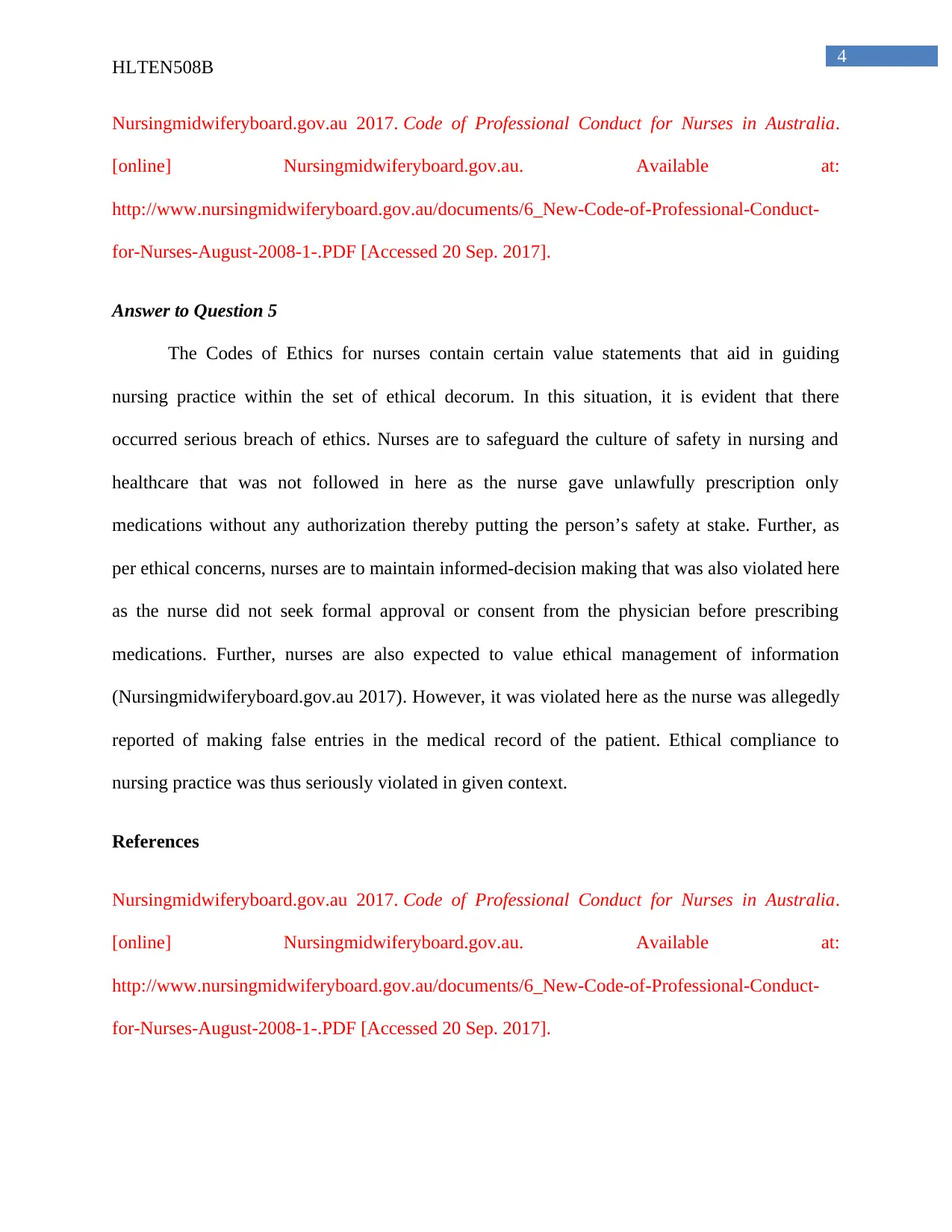
4
HLTEN508B
Nursingmidwiferyboard.gov.au 2017. Code of Professional Conduct for Nurses in Australia.
[online] Nursingmidwiferyboard.gov.au. Available at:
http://www.nursingmidwiferyboard.gov.au/documents/6_New-Code-of-Professional-Conduct-
for-Nurses-August-2008-1-.PDF [Accessed 20 Sep. 2017].
Answer to Question 5
The Codes of Ethics for nurses contain certain value statements that aid in guiding
nursing practice within the set of ethical decorum. In this situation, it is evident that there
occurred serious breach of ethics. Nurses are to safeguard the culture of safety in nursing and
healthcare that was not followed in here as the nurse gave unlawfully prescription only
medications without any authorization thereby putting the person’s safety at stake. Further, as
per ethical concerns, nurses are to maintain informed-decision making that was also violated here
as the nurse did not seek formal approval or consent from the physician before prescribing
medications. Further, nurses are also expected to value ethical management of information
(Nursingmidwiferyboard.gov.au 2017). However, it was violated here as the nurse was allegedly
reported of making false entries in the medical record of the patient. Ethical compliance to
nursing practice was thus seriously violated in given context.
References
Nursingmidwiferyboard.gov.au 2017. Code of Professional Conduct for Nurses in Australia.
[online] Nursingmidwiferyboard.gov.au. Available at:
http://www.nursingmidwiferyboard.gov.au/documents/6_New-Code-of-Professional-Conduct-
for-Nurses-August-2008-1-.PDF [Accessed 20 Sep. 2017].
HLTEN508B
Nursingmidwiferyboard.gov.au 2017. Code of Professional Conduct for Nurses in Australia.
[online] Nursingmidwiferyboard.gov.au. Available at:
http://www.nursingmidwiferyboard.gov.au/documents/6_New-Code-of-Professional-Conduct-
for-Nurses-August-2008-1-.PDF [Accessed 20 Sep. 2017].
Answer to Question 5
The Codes of Ethics for nurses contain certain value statements that aid in guiding
nursing practice within the set of ethical decorum. In this situation, it is evident that there
occurred serious breach of ethics. Nurses are to safeguard the culture of safety in nursing and
healthcare that was not followed in here as the nurse gave unlawfully prescription only
medications without any authorization thereby putting the person’s safety at stake. Further, as
per ethical concerns, nurses are to maintain informed-decision making that was also violated here
as the nurse did not seek formal approval or consent from the physician before prescribing
medications. Further, nurses are also expected to value ethical management of information
(Nursingmidwiferyboard.gov.au 2017). However, it was violated here as the nurse was allegedly
reported of making false entries in the medical record of the patient. Ethical compliance to
nursing practice was thus seriously violated in given context.
References
Nursingmidwiferyboard.gov.au 2017. Code of Professional Conduct for Nurses in Australia.
[online] Nursingmidwiferyboard.gov.au. Available at:
http://www.nursingmidwiferyboard.gov.au/documents/6_New-Code-of-Professional-Conduct-
for-Nurses-August-2008-1-.PDF [Accessed 20 Sep. 2017].
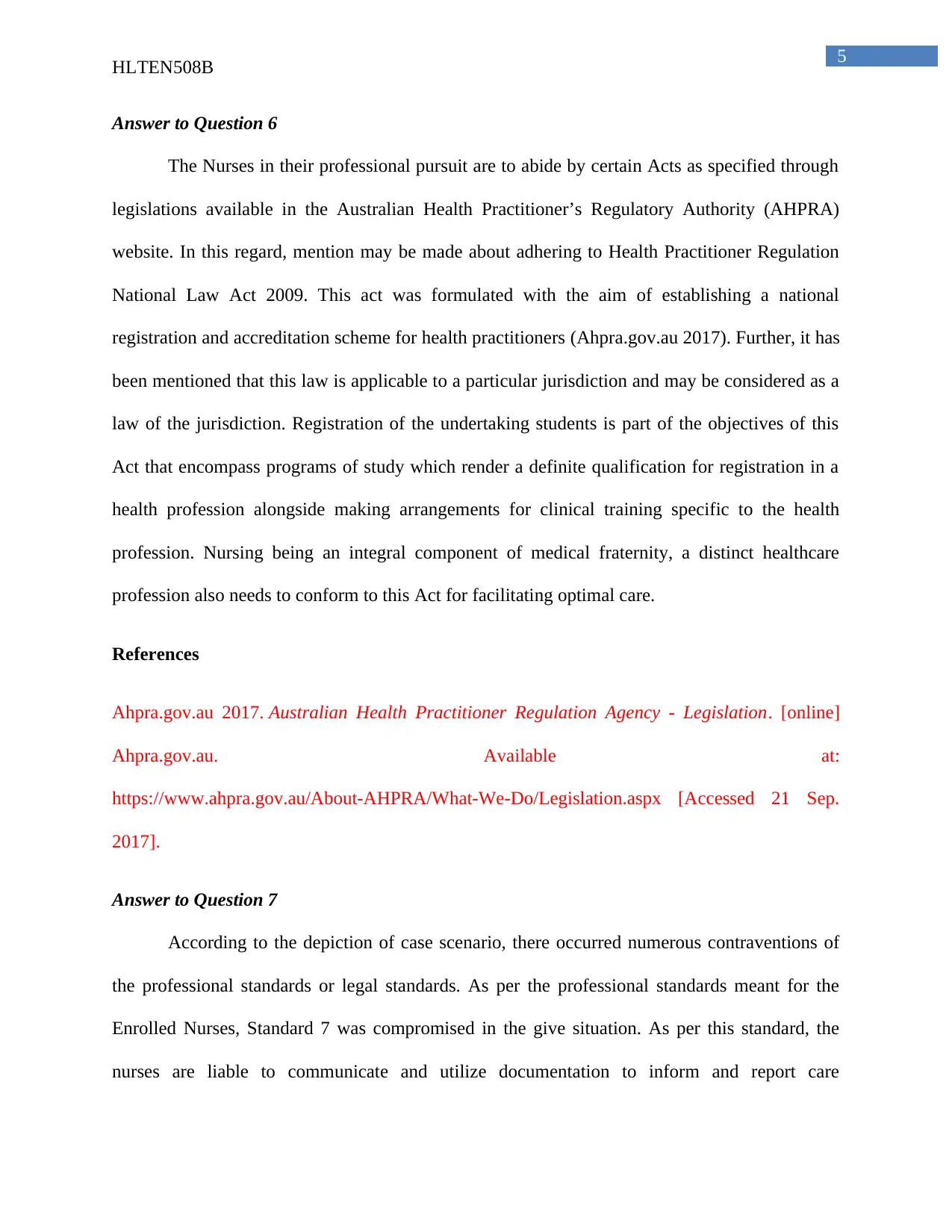
5
HLTEN508B
Answer to Question 6
The Nurses in their professional pursuit are to abide by certain Acts as specified through
legislations available in the Australian Health Practitioner’s Regulatory Authority (AHPRA)
website. In this regard, mention may be made about adhering to Health Practitioner Regulation
National Law Act 2009. This act was formulated with the aim of establishing a national
registration and accreditation scheme for health practitioners (Ahpra.gov.au 2017). Further, it has
been mentioned that this law is applicable to a particular jurisdiction and may be considered as a
law of the jurisdiction. Registration of the undertaking students is part of the objectives of this
Act that encompass programs of study which render a definite qualification for registration in a
health profession alongside making arrangements for clinical training specific to the health
profession. Nursing being an integral component of medical fraternity, a distinct healthcare
profession also needs to conform to this Act for facilitating optimal care.
References
Ahpra.gov.au 2017. Australian Health Practitioner Regulation Agency - Legislation. [online]
Ahpra.gov.au. Available at:
https://www.ahpra.gov.au/About-AHPRA/What-We-Do/Legislation.aspx [Accessed 21 Sep.
2017].
Answer to Question 7
According to the depiction of case scenario, there occurred numerous contraventions of
the professional standards or legal standards. As per the professional standards meant for the
Enrolled Nurses, Standard 7 was compromised in the give situation. As per this standard, the
nurses are liable to communicate and utilize documentation to inform and report care
HLTEN508B
Answer to Question 6
The Nurses in their professional pursuit are to abide by certain Acts as specified through
legislations available in the Australian Health Practitioner’s Regulatory Authority (AHPRA)
website. In this regard, mention may be made about adhering to Health Practitioner Regulation
National Law Act 2009. This act was formulated with the aim of establishing a national
registration and accreditation scheme for health practitioners (Ahpra.gov.au 2017). Further, it has
been mentioned that this law is applicable to a particular jurisdiction and may be considered as a
law of the jurisdiction. Registration of the undertaking students is part of the objectives of this
Act that encompass programs of study which render a definite qualification for registration in a
health profession alongside making arrangements for clinical training specific to the health
profession. Nursing being an integral component of medical fraternity, a distinct healthcare
profession also needs to conform to this Act for facilitating optimal care.
References
Ahpra.gov.au 2017. Australian Health Practitioner Regulation Agency - Legislation. [online]
Ahpra.gov.au. Available at:
https://www.ahpra.gov.au/About-AHPRA/What-We-Do/Legislation.aspx [Accessed 21 Sep.
2017].
Answer to Question 7
According to the depiction of case scenario, there occurred numerous contraventions of
the professional standards or legal standards. As per the professional standards meant for the
Enrolled Nurses, Standard 7 was compromised in the give situation. As per this standard, the
nurses are liable to communicate and utilize documentation to inform and report care
⊘ This is a preview!⊘
Do you want full access?
Subscribe today to unlock all pages.

Trusted by 1+ million students worldwide
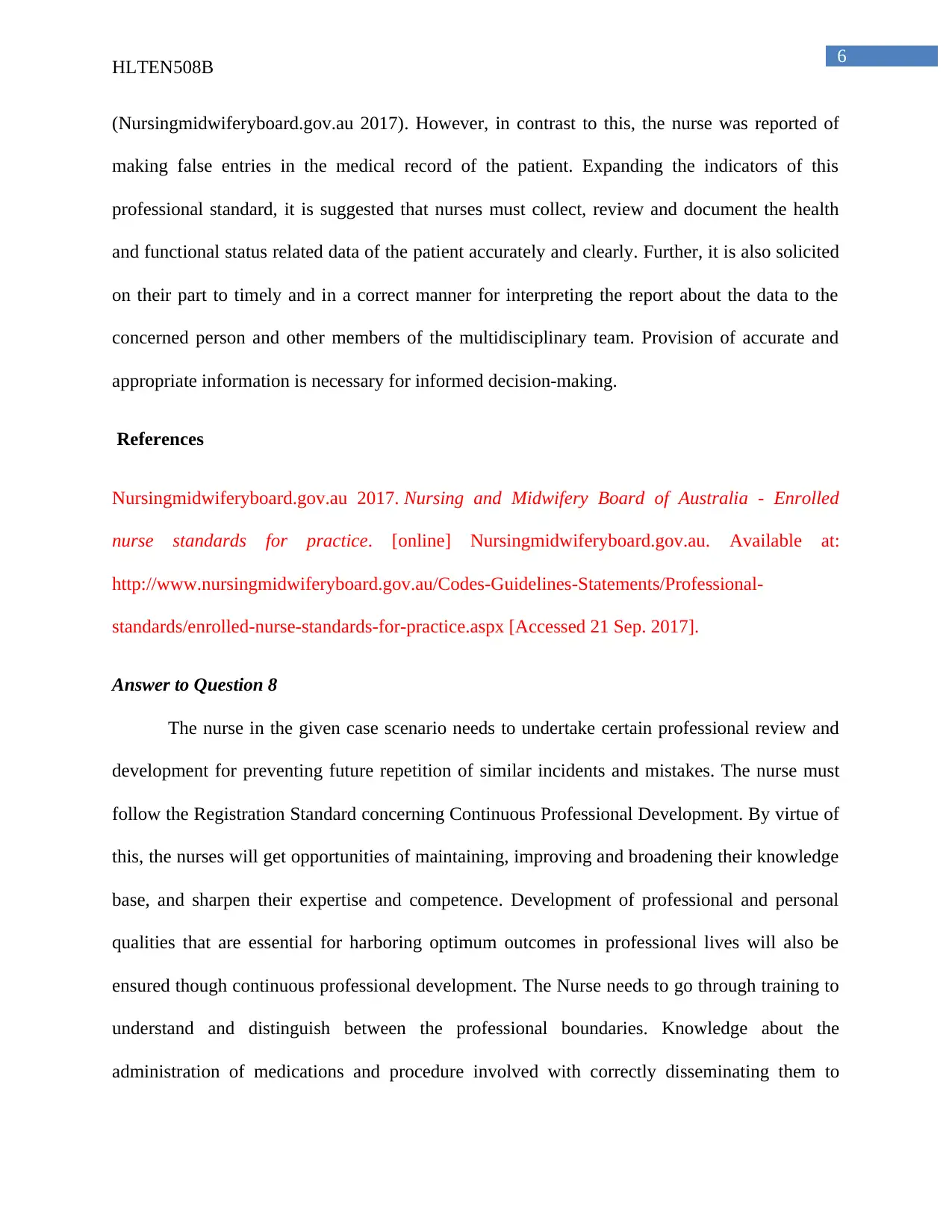
6
HLTEN508B
(Nursingmidwiferyboard.gov.au 2017). However, in contrast to this, the nurse was reported of
making false entries in the medical record of the patient. Expanding the indicators of this
professional standard, it is suggested that nurses must collect, review and document the health
and functional status related data of the patient accurately and clearly. Further, it is also solicited
on their part to timely and in a correct manner for interpreting the report about the data to the
concerned person and other members of the multidisciplinary team. Provision of accurate and
appropriate information is necessary for informed decision-making.
References
Nursingmidwiferyboard.gov.au 2017. Nursing and Midwifery Board of Australia - Enrolled
nurse standards for practice. [online] Nursingmidwiferyboard.gov.au. Available at:
http://www.nursingmidwiferyboard.gov.au/Codes-Guidelines-Statements/Professional-
standards/enrolled-nurse-standards-for-practice.aspx [Accessed 21 Sep. 2017].
Answer to Question 8
The nurse in the given case scenario needs to undertake certain professional review and
development for preventing future repetition of similar incidents and mistakes. The nurse must
follow the Registration Standard concerning Continuous Professional Development. By virtue of
this, the nurses will get opportunities of maintaining, improving and broadening their knowledge
base, and sharpen their expertise and competence. Development of professional and personal
qualities that are essential for harboring optimum outcomes in professional lives will also be
ensured though continuous professional development. The Nurse needs to go through training to
understand and distinguish between the professional boundaries. Knowledge about the
administration of medications and procedure involved with correctly disseminating them to
HLTEN508B
(Nursingmidwiferyboard.gov.au 2017). However, in contrast to this, the nurse was reported of
making false entries in the medical record of the patient. Expanding the indicators of this
professional standard, it is suggested that nurses must collect, review and document the health
and functional status related data of the patient accurately and clearly. Further, it is also solicited
on their part to timely and in a correct manner for interpreting the report about the data to the
concerned person and other members of the multidisciplinary team. Provision of accurate and
appropriate information is necessary for informed decision-making.
References
Nursingmidwiferyboard.gov.au 2017. Nursing and Midwifery Board of Australia - Enrolled
nurse standards for practice. [online] Nursingmidwiferyboard.gov.au. Available at:
http://www.nursingmidwiferyboard.gov.au/Codes-Guidelines-Statements/Professional-
standards/enrolled-nurse-standards-for-practice.aspx [Accessed 21 Sep. 2017].
Answer to Question 8
The nurse in the given case scenario needs to undertake certain professional review and
development for preventing future repetition of similar incidents and mistakes. The nurse must
follow the Registration Standard concerning Continuous Professional Development. By virtue of
this, the nurses will get opportunities of maintaining, improving and broadening their knowledge
base, and sharpen their expertise and competence. Development of professional and personal
qualities that are essential for harboring optimum outcomes in professional lives will also be
ensured though continuous professional development. The Nurse needs to go through training to
understand and distinguish between the professional boundaries. Knowledge about the
administration of medications and procedure involved with correctly disseminating them to
Paraphrase This Document
Need a fresh take? Get an instant paraphrase of this document with our AI Paraphraser
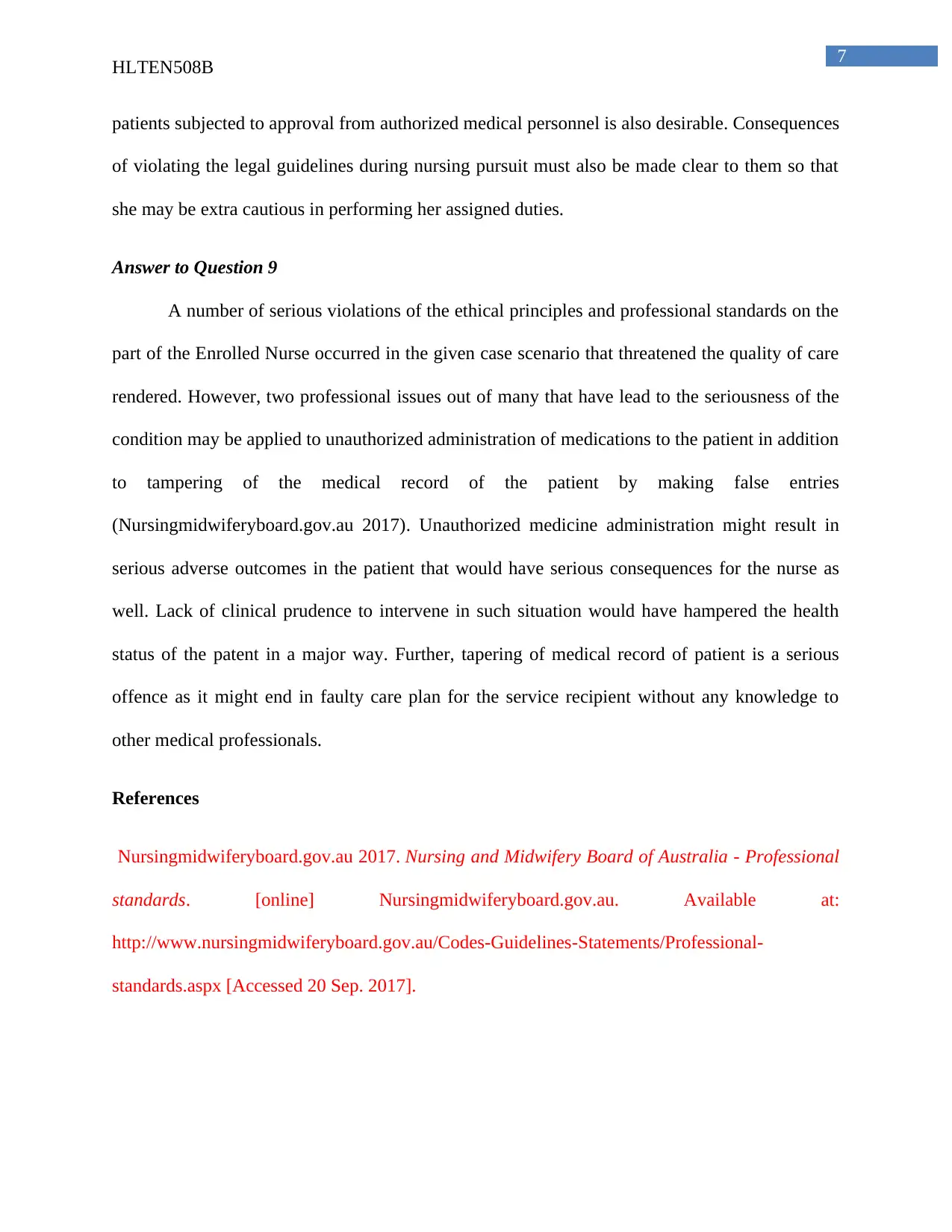
7
HLTEN508B
patients subjected to approval from authorized medical personnel is also desirable. Consequences
of violating the legal guidelines during nursing pursuit must also be made clear to them so that
she may be extra cautious in performing her assigned duties.
Answer to Question 9
A number of serious violations of the ethical principles and professional standards on the
part of the Enrolled Nurse occurred in the given case scenario that threatened the quality of care
rendered. However, two professional issues out of many that have lead to the seriousness of the
condition may be applied to unauthorized administration of medications to the patient in addition
to tampering of the medical record of the patient by making false entries
(Nursingmidwiferyboard.gov.au 2017). Unauthorized medicine administration might result in
serious adverse outcomes in the patient that would have serious consequences for the nurse as
well. Lack of clinical prudence to intervene in such situation would have hampered the health
status of the patent in a major way. Further, tapering of medical record of patient is a serious
offence as it might end in faulty care plan for the service recipient without any knowledge to
other medical professionals.
References
Nursingmidwiferyboard.gov.au 2017. Nursing and Midwifery Board of Australia - Professional
standards. [online] Nursingmidwiferyboard.gov.au. Available at:
http://www.nursingmidwiferyboard.gov.au/Codes-Guidelines-Statements/Professional-
standards.aspx [Accessed 20 Sep. 2017].
HLTEN508B
patients subjected to approval from authorized medical personnel is also desirable. Consequences
of violating the legal guidelines during nursing pursuit must also be made clear to them so that
she may be extra cautious in performing her assigned duties.
Answer to Question 9
A number of serious violations of the ethical principles and professional standards on the
part of the Enrolled Nurse occurred in the given case scenario that threatened the quality of care
rendered. However, two professional issues out of many that have lead to the seriousness of the
condition may be applied to unauthorized administration of medications to the patient in addition
to tampering of the medical record of the patient by making false entries
(Nursingmidwiferyboard.gov.au 2017). Unauthorized medicine administration might result in
serious adverse outcomes in the patient that would have serious consequences for the nurse as
well. Lack of clinical prudence to intervene in such situation would have hampered the health
status of the patent in a major way. Further, tapering of medical record of patient is a serious
offence as it might end in faulty care plan for the service recipient without any knowledge to
other medical professionals.
References
Nursingmidwiferyboard.gov.au 2017. Nursing and Midwifery Board of Australia - Professional
standards. [online] Nursingmidwiferyboard.gov.au. Available at:
http://www.nursingmidwiferyboard.gov.au/Codes-Guidelines-Statements/Professional-
standards.aspx [Accessed 20 Sep. 2017].
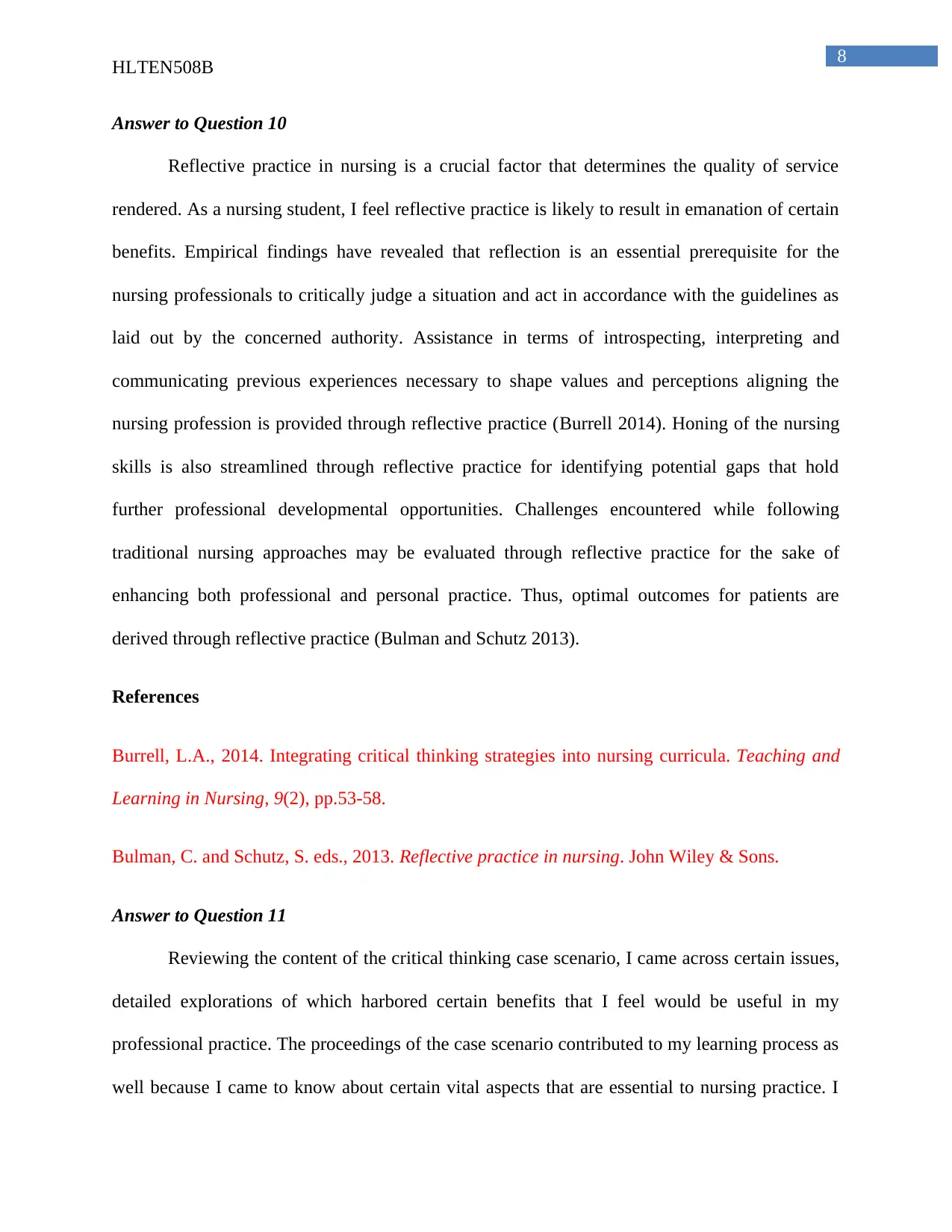
8
HLTEN508B
Answer to Question 10
Reflective practice in nursing is a crucial factor that determines the quality of service
rendered. As a nursing student, I feel reflective practice is likely to result in emanation of certain
benefits. Empirical findings have revealed that reflection is an essential prerequisite for the
nursing professionals to critically judge a situation and act in accordance with the guidelines as
laid out by the concerned authority. Assistance in terms of introspecting, interpreting and
communicating previous experiences necessary to shape values and perceptions aligning the
nursing profession is provided through reflective practice (Burrell 2014). Honing of the nursing
skills is also streamlined through reflective practice for identifying potential gaps that hold
further professional developmental opportunities. Challenges encountered while following
traditional nursing approaches may be evaluated through reflective practice for the sake of
enhancing both professional and personal practice. Thus, optimal outcomes for patients are
derived through reflective practice (Bulman and Schutz 2013).
References
Burrell, L.A., 2014. Integrating critical thinking strategies into nursing curricula. Teaching and
Learning in Nursing, 9(2), pp.53-58.
Bulman, C. and Schutz, S. eds., 2013. Reflective practice in nursing. John Wiley & Sons.
Answer to Question 11
Reviewing the content of the critical thinking case scenario, I came across certain issues,
detailed explorations of which harbored certain benefits that I feel would be useful in my
professional practice. The proceedings of the case scenario contributed to my learning process as
well because I came to know about certain vital aspects that are essential to nursing practice. I
HLTEN508B
Answer to Question 10
Reflective practice in nursing is a crucial factor that determines the quality of service
rendered. As a nursing student, I feel reflective practice is likely to result in emanation of certain
benefits. Empirical findings have revealed that reflection is an essential prerequisite for the
nursing professionals to critically judge a situation and act in accordance with the guidelines as
laid out by the concerned authority. Assistance in terms of introspecting, interpreting and
communicating previous experiences necessary to shape values and perceptions aligning the
nursing profession is provided through reflective practice (Burrell 2014). Honing of the nursing
skills is also streamlined through reflective practice for identifying potential gaps that hold
further professional developmental opportunities. Challenges encountered while following
traditional nursing approaches may be evaluated through reflective practice for the sake of
enhancing both professional and personal practice. Thus, optimal outcomes for patients are
derived through reflective practice (Bulman and Schutz 2013).
References
Burrell, L.A., 2014. Integrating critical thinking strategies into nursing curricula. Teaching and
Learning in Nursing, 9(2), pp.53-58.
Bulman, C. and Schutz, S. eds., 2013. Reflective practice in nursing. John Wiley & Sons.
Answer to Question 11
Reviewing the content of the critical thinking case scenario, I came across certain issues,
detailed explorations of which harbored certain benefits that I feel would be useful in my
professional practice. The proceedings of the case scenario contributed to my learning process as
well because I came to know about certain vital aspects that are essential to nursing practice. I
⊘ This is a preview!⊘
Do you want full access?
Subscribe today to unlock all pages.

Trusted by 1+ million students worldwide
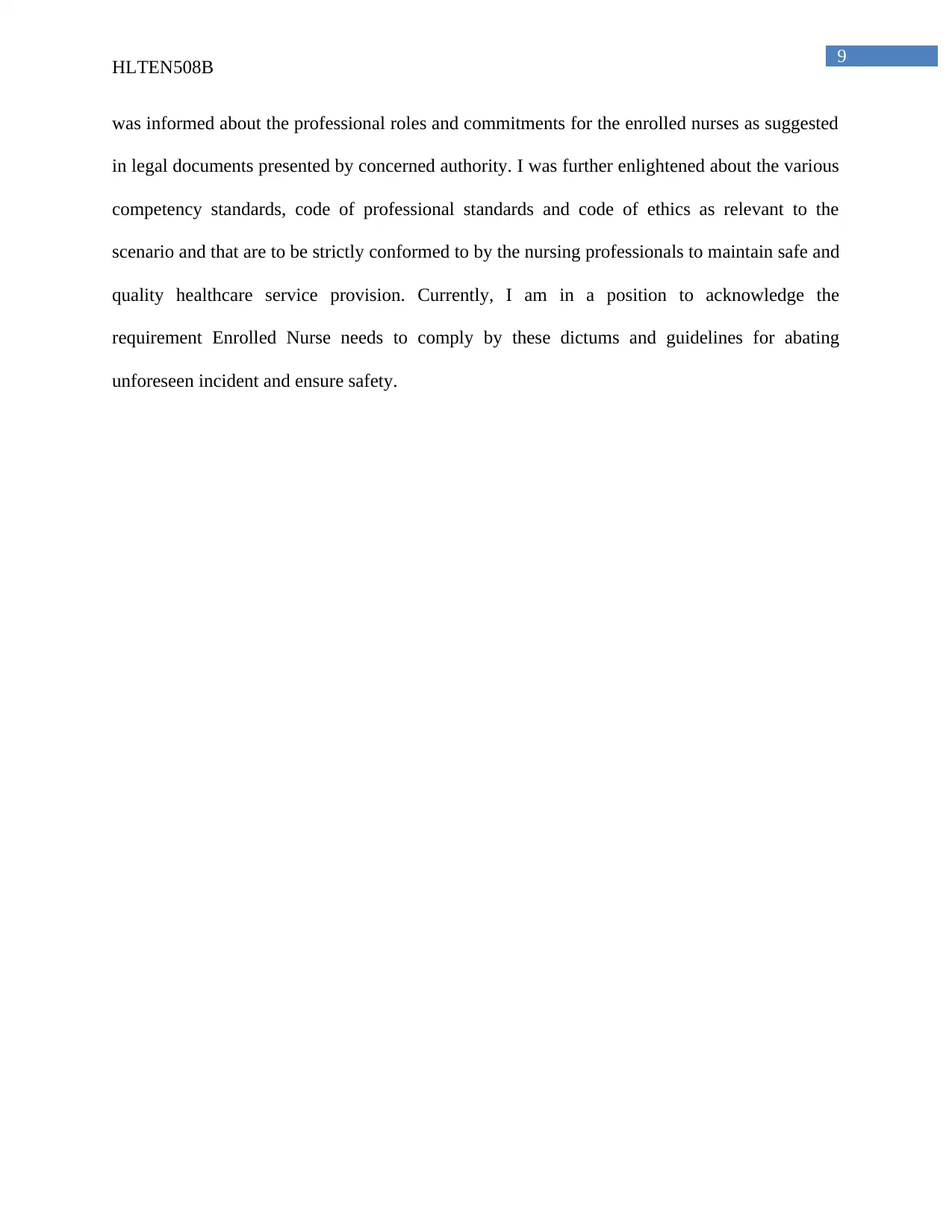
9
HLTEN508B
was informed about the professional roles and commitments for the enrolled nurses as suggested
in legal documents presented by concerned authority. I was further enlightened about the various
competency standards, code of professional standards and code of ethics as relevant to the
scenario and that are to be strictly conformed to by the nursing professionals to maintain safe and
quality healthcare service provision. Currently, I am in a position to acknowledge the
requirement Enrolled Nurse needs to comply by these dictums and guidelines for abating
unforeseen incident and ensure safety.
HLTEN508B
was informed about the professional roles and commitments for the enrolled nurses as suggested
in legal documents presented by concerned authority. I was further enlightened about the various
competency standards, code of professional standards and code of ethics as relevant to the
scenario and that are to be strictly conformed to by the nursing professionals to maintain safe and
quality healthcare service provision. Currently, I am in a position to acknowledge the
requirement Enrolled Nurse needs to comply by these dictums and guidelines for abating
unforeseen incident and ensure safety.
Paraphrase This Document
Need a fresh take? Get an instant paraphrase of this document with our AI Paraphraser
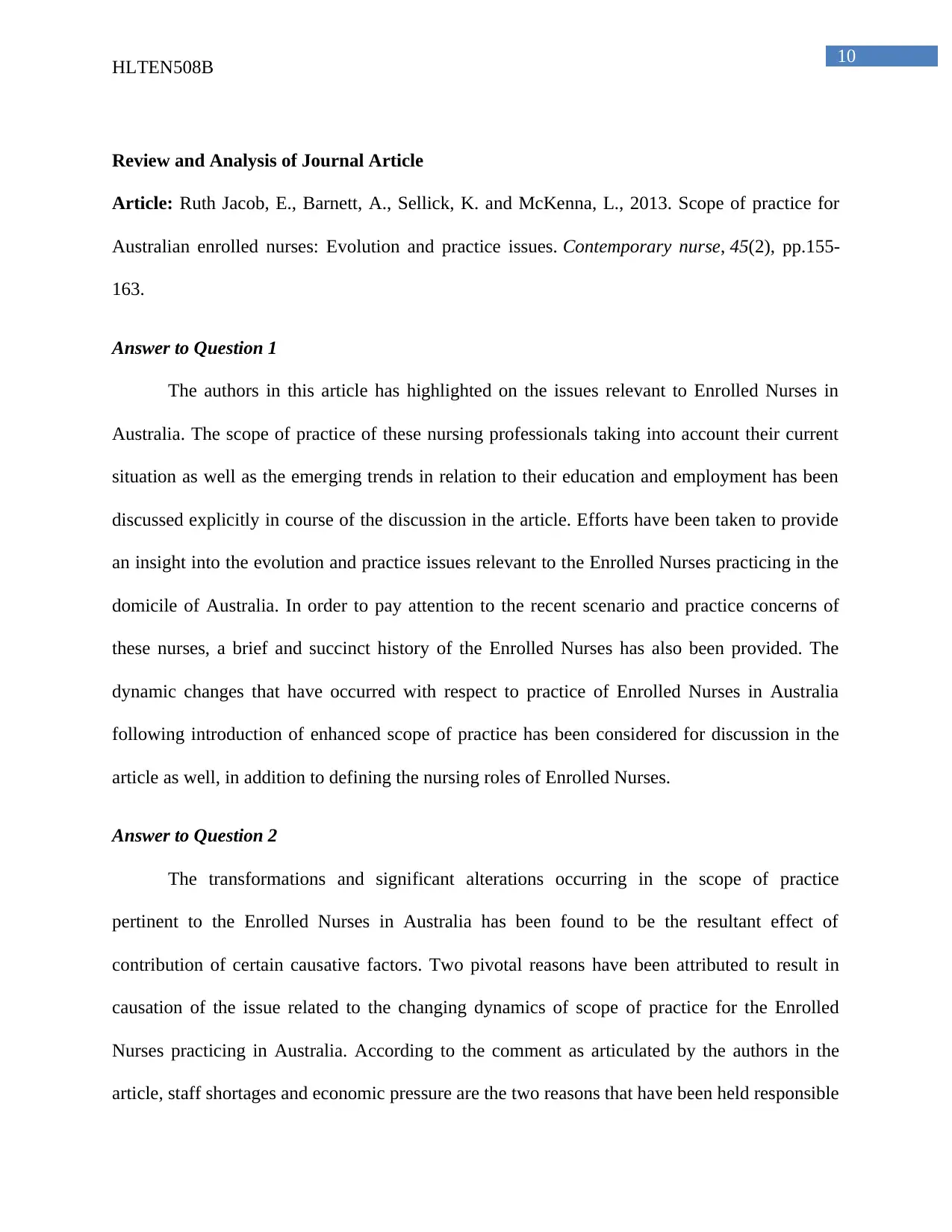
10
HLTEN508B
Review and Analysis of Journal Article
Article: Ruth Jacob, E., Barnett, A., Sellick, K. and McKenna, L., 2013. Scope of practice for
Australian enrolled nurses: Evolution and practice issues. Contemporary nurse, 45(2), pp.155-
163.
Answer to Question 1
The authors in this article has highlighted on the issues relevant to Enrolled Nurses in
Australia. The scope of practice of these nursing professionals taking into account their current
situation as well as the emerging trends in relation to their education and employment has been
discussed explicitly in course of the discussion in the article. Efforts have been taken to provide
an insight into the evolution and practice issues relevant to the Enrolled Nurses practicing in the
domicile of Australia. In order to pay attention to the recent scenario and practice concerns of
these nurses, a brief and succinct history of the Enrolled Nurses has also been provided. The
dynamic changes that have occurred with respect to practice of Enrolled Nurses in Australia
following introduction of enhanced scope of practice has been considered for discussion in the
article as well, in addition to defining the nursing roles of Enrolled Nurses.
Answer to Question 2
The transformations and significant alterations occurring in the scope of practice
pertinent to the Enrolled Nurses in Australia has been found to be the resultant effect of
contribution of certain causative factors. Two pivotal reasons have been attributed to result in
causation of the issue related to the changing dynamics of scope of practice for the Enrolled
Nurses practicing in Australia. According to the comment as articulated by the authors in the
article, staff shortages and economic pressure are the two reasons that have been held responsible
HLTEN508B
Review and Analysis of Journal Article
Article: Ruth Jacob, E., Barnett, A., Sellick, K. and McKenna, L., 2013. Scope of practice for
Australian enrolled nurses: Evolution and practice issues. Contemporary nurse, 45(2), pp.155-
163.
Answer to Question 1
The authors in this article has highlighted on the issues relevant to Enrolled Nurses in
Australia. The scope of practice of these nursing professionals taking into account their current
situation as well as the emerging trends in relation to their education and employment has been
discussed explicitly in course of the discussion in the article. Efforts have been taken to provide
an insight into the evolution and practice issues relevant to the Enrolled Nurses practicing in the
domicile of Australia. In order to pay attention to the recent scenario and practice concerns of
these nurses, a brief and succinct history of the Enrolled Nurses has also been provided. The
dynamic changes that have occurred with respect to practice of Enrolled Nurses in Australia
following introduction of enhanced scope of practice has been considered for discussion in the
article as well, in addition to defining the nursing roles of Enrolled Nurses.
Answer to Question 2
The transformations and significant alterations occurring in the scope of practice
pertinent to the Enrolled Nurses in Australia has been found to be the resultant effect of
contribution of certain causative factors. Two pivotal reasons have been attributed to result in
causation of the issue related to the changing dynamics of scope of practice for the Enrolled
Nurses practicing in Australia. According to the comment as articulated by the authors in the
article, staff shortages and economic pressure are the two reasons that have been held responsible
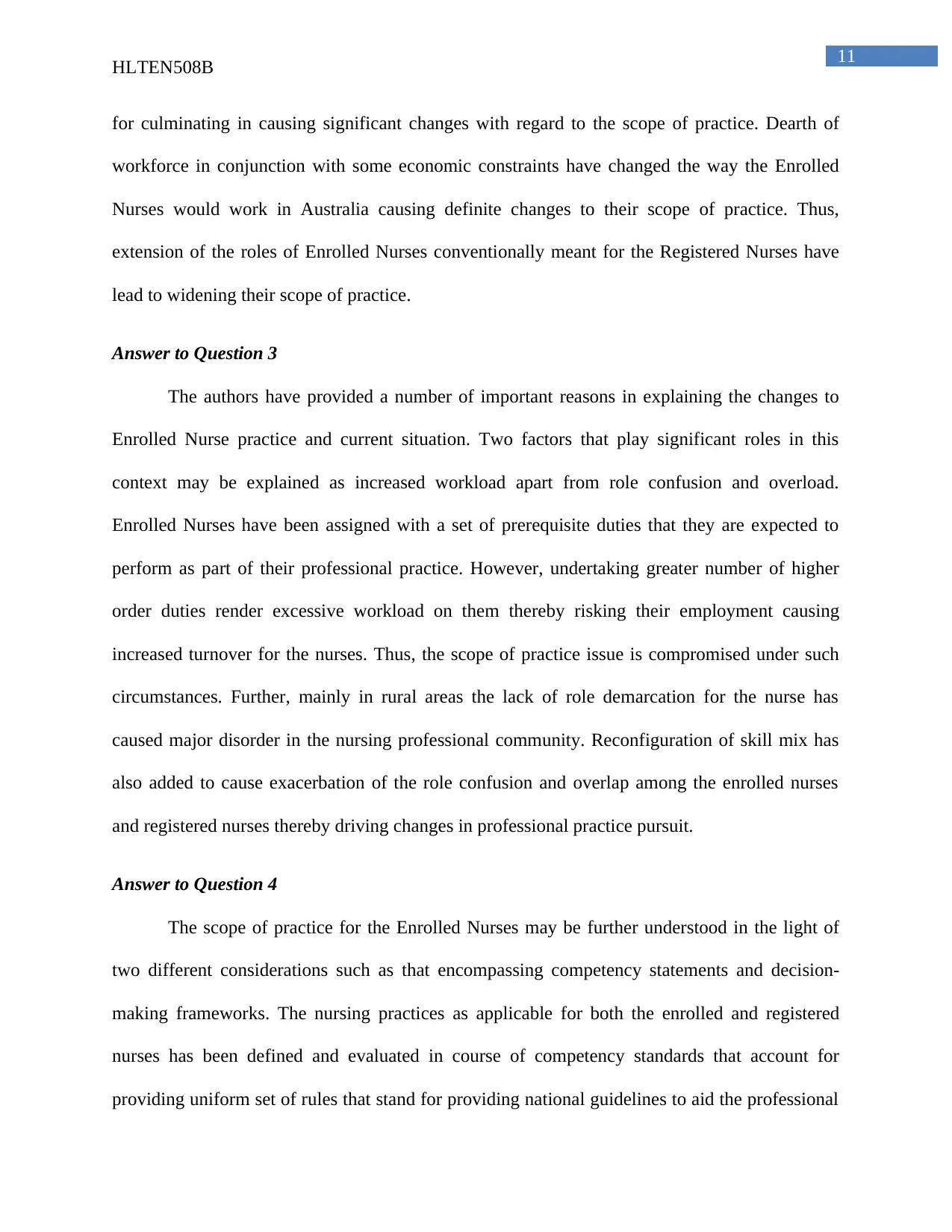
11
HLTEN508B
for culminating in causing significant changes with regard to the scope of practice. Dearth of
workforce in conjunction with some economic constraints have changed the way the Enrolled
Nurses would work in Australia causing definite changes to their scope of practice. Thus,
extension of the roles of Enrolled Nurses conventionally meant for the Registered Nurses have
lead to widening their scope of practice.
Answer to Question 3
The authors have provided a number of important reasons in explaining the changes to
Enrolled Nurse practice and current situation. Two factors that play significant roles in this
context may be explained as increased workload apart from role confusion and overload.
Enrolled Nurses have been assigned with a set of prerequisite duties that they are expected to
perform as part of their professional practice. However, undertaking greater number of higher
order duties render excessive workload on them thereby risking their employment causing
increased turnover for the nurses. Thus, the scope of practice issue is compromised under such
circumstances. Further, mainly in rural areas the lack of role demarcation for the nurse has
caused major disorder in the nursing professional community. Reconfiguration of skill mix has
also added to cause exacerbation of the role confusion and overlap among the enrolled nurses
and registered nurses thereby driving changes in professional practice pursuit.
Answer to Question 4
The scope of practice for the Enrolled Nurses may be further understood in the light of
two different considerations such as that encompassing competency statements and decision-
making frameworks. The nursing practices as applicable for both the enrolled and registered
nurses has been defined and evaluated in course of competency standards that account for
providing uniform set of rules that stand for providing national guidelines to aid the professional
HLTEN508B
for culminating in causing significant changes with regard to the scope of practice. Dearth of
workforce in conjunction with some economic constraints have changed the way the Enrolled
Nurses would work in Australia causing definite changes to their scope of practice. Thus,
extension of the roles of Enrolled Nurses conventionally meant for the Registered Nurses have
lead to widening their scope of practice.
Answer to Question 3
The authors have provided a number of important reasons in explaining the changes to
Enrolled Nurse practice and current situation. Two factors that play significant roles in this
context may be explained as increased workload apart from role confusion and overload.
Enrolled Nurses have been assigned with a set of prerequisite duties that they are expected to
perform as part of their professional practice. However, undertaking greater number of higher
order duties render excessive workload on them thereby risking their employment causing
increased turnover for the nurses. Thus, the scope of practice issue is compromised under such
circumstances. Further, mainly in rural areas the lack of role demarcation for the nurse has
caused major disorder in the nursing professional community. Reconfiguration of skill mix has
also added to cause exacerbation of the role confusion and overlap among the enrolled nurses
and registered nurses thereby driving changes in professional practice pursuit.
Answer to Question 4
The scope of practice for the Enrolled Nurses may be further understood in the light of
two different considerations such as that encompassing competency statements and decision-
making frameworks. The nursing practices as applicable for both the enrolled and registered
nurses has been defined and evaluated in course of competency standards that account for
providing uniform set of rules that stand for providing national guidelines to aid the professional
⊘ This is a preview!⊘
Do you want full access?
Subscribe today to unlock all pages.

Trusted by 1+ million students worldwide
1 out of 13
Related Documents
Your All-in-One AI-Powered Toolkit for Academic Success.
+13062052269
info@desklib.com
Available 24*7 on WhatsApp / Email
![[object Object]](/_next/static/media/star-bottom.7253800d.svg)
Unlock your academic potential
Copyright © 2020–2025 A2Z Services. All Rights Reserved. Developed and managed by ZUCOL.

![NURS6120: NMBA v Jones [2017] Case Study - Nursing Accountability](/_next/image/?url=https%3A%2F%2Fdesklib.com%2Fmedia%2Fnursing-midwifery-board-jones-2017_page_2.jpg&w=256&q=75)



